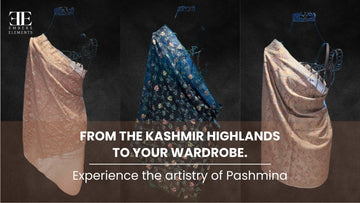A handwoven Pashmina shawl is not just an accessory; it is a masterpiece of craftsmanship, history, and luxury. Made from the softest cashmere wool, these exquisite shawls go through an intricate process that transforms raw fiber into a work of art. Let’s take a journey from the high-altitude pastures where the wool is collected to the skilled hands that weave these breathtaking garments.
Step 1: Sourcing the Finest Cashmere Wool
The journey of a Pashmina shawl begins in the Himalayan region, where a special breed of goats, known as Changthangi goats, thrive in the cold. These goats grow a warm and ultra-soft undercoat to survive the harsh winters.
-
Collection Process: In spring, when temperatures rise, the goats naturally shed their undercoat. Skilled herders carefully collect the wool without harming the animals.
-
Rarity of the Fiber: Each goat produces only 80-170 grams of Pashmina wool per year, making the fabric incredibly rare and valuable.
Step 2: Cleaning and Sorting the Wool
Once collected, the raw wool is taken through an intensive cleaning process to remove dirt, grease, and impurities.
-
Hand Sorting: Skilled artisans manually separate the finest fibres from coarser ones.
-
Gentle Washing: The wool is washed using mild, eco-friendly detergents to maintain its softness.
This meticulous process ensures that only the highest quality cashmere is used to make genuine handwoven Pashmina shawls.
Step 3: Spinning the Wool into Yarn
Unlike machine-spun fibres, authentic Pashmina wool is hand-spun by expert artisans, often using a traditional spinning wheel called a Charkha.
-
Why Hand-Spinning? Machine spinning can break delicate Pashmina fibres, reducing their softness. Hand-spinning preserves the fiber’s natural warmth and texture.
-
Time-Consuming Art: It can take weeks to spin enough yarn for a single shawl, highlighting the patience and skill involved.

Step 4: The Weaving Process – A True Work of Art
Once spun, the delicate yarn is woven by master weavers using traditional wooden looms. This is where the magic happens!
-
Hand-Weaving Expertise: Each shawl takes several weeks to months to weave, depending on the design and intricacy.
-
Timeless Designs: Many Pashmina shawls feature heritage weaving patterns passed down through generations.
Step 5: Dyeing & Embellishment
To enhance their beauty, some Pashmina shawls are dyed using natural or azo-free dyes.
-
Hand-Dyeing Process: Natural plant-based dyes are often used to achieve rich, long-lasting colors.
-
Hand-Embroidered Details: Some shawls are adorned with exquisite embroidery, which takes artisans months to complete.
Each shawl becomes a wearable work of art, reflecting the craftsmanship and cultural heritage of its makers.
Step 6: Finishing Touches & Quality Control
Before reaching customers, every Pashmina shawl undergoes rigorous quality checks.
-
Softening & Polishing: The shawls are hand-polished using a special technique to enhance their softness and sheen.
-
Final Inspection: Experts ensure that there are no imperfections, ensuring that each piece is flawless and ready for the world to admire.

Why Choose a Handwoven Pashmina Shawl?
Investing in a genuine Pashmina shawl means owning a luxurious, heirloom-quality piece. Here’s why Pashmina is worth it:
✅ Unmatched Softness: Pashmina is the finest form of cashmere, offering exceptional warmth and lightweight comfort. ✅ Handcrafted Excellence: Every shawl is woven by artisans, ensuring authenticity and superior craftsmanship. ✅ Timeless Elegance: A Pashmina shawl complements any wardrobe and remains stylish for years to come. ✅ Sustainable Fashion: Handwoven Pashmina is an eco-friendly alternative to mass-produced synthetic fabrics.
Final Thoughts
A handwoven Pashmina shawl is more than just fabric—it is a testament to tradition, skill, and luxury. From the Himalayan goats that provide the raw wool to the dedicated artisans who weave it by hand, every step of the journey is filled with craftsmanship and heritage.
When you wrap yourself in a Pashmina shawl, you are embracing centuries of artisanal skill, ethical fashion, and timeless elegance. Whether as a personal indulgence or a meaningful gift, a Pashmina shawl is an investment in beauty, warmth, and culture.
Discover the magic of handwoven Pashmina today and experience true luxury firsthand!





